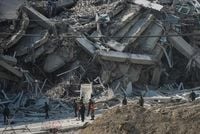On March 28, 2025, a powerful magnitude 7.7 earthquake struck near Mandalay, Myanmar, sending shockwaves that were felt across the region, including in Bangkok, Thailand. The tremors were so intense that they prompted widespread panic among residents in Bangkok, who had never experienced such an event before.
The U.S. Geological Survey (USGS) reported that the earthquake's epicenter was located approximately 16 kilometers northwest of Sagaing, Myanmar, and at a depth of only 10 kilometers. This shallow depth contributed to the strength of the tremors felt in neighboring countries, including Thailand and China.
In Bangkok, home to over 17 million people, the response was immediate. High-rise office buildings in commercial districts like Sukhumvit and Siam initiated emergency evacuation procedures as the ground shook. Many residents fled their offices, crowding the streets in fear, with some reportedly crying and expressing disbelief at the earthquake's intensity. "I thought it was just a headache at first," said April Kanichawanakul, who evacuated from the 10th floor of her office building.
Footage from the scene showed chaos as people rushed outdoors, with some department stores, such as Siam Paragon and CentralWorld, temporarily closing their doors to ensure customer safety. The Bangkok Metropolitan Administration declared the entire city a disaster area to facilitate coordinated rescue efforts.
Despite the panic, initial reports from the Thai Interior Ministry indicated that there were no immediate casualties or significant property damage within Thailand. However, the government activated its earthquake emergency mechanism, with the Department of Disaster Prevention and Mitigation requesting provincial assessments of potential damage. Hospitals were put on high alert, and engineering teams began inspecting critical infrastructure, including bridges and high-rise buildings, to ensure their safety.
Meanwhile, the situation in Myanmar remains dire. The Myanmar government has declared a state of emergency in six regions, including the capital Naypyidaw and Mandalay, as they assess the damage and casualties caused by the earthquake. Reports indicate that the affected areas urgently need blood donations, and images of collapsed buildings and cracked roads have circulated on social media, highlighting the severity of the disaster.
In Bangkok, the tremors caused a building under construction in the Huai Khwang district to collapse, trapping an estimated 50 workers inside. Rescue teams were deployed to the scene to assist in recovery efforts. Sirens blared throughout the city as traffic became congested, further complicating the emergency response.
The earthquake's impact on Bangkok is particularly noteworthy given the city's vulnerability to seismic events. Research conducted by the Asian Institute of Technology (AIT) indicates that Bangkok is susceptible to strong earthquakes from afar, with potential risks of building collapses. A 2014 study noted that if a powerful earthquake were to occur, approximately 1% of high-rise buildings could be at risk of collapsing.
Dr. Pennung Warnitchai, an earthquake expert at AIT, has long warned about the city's structural vulnerabilities. He explained that the unique geology of Bangkok, characterized by soft sedimentary layers, can amplify seismic waves, potentially leading to more severe shaking. "We have records showing that the shaking intensity in Bangkok could be three to four times greater than in surrounding areas," he cautioned.
Historically, Bangkok has felt the effects of distant earthquakes, such as the 2008 Sichuan earthquake in China, which was over 2,000 kilometers away, and the 2012 earthquake in Mandalay, which was felt 700 kilometers away. These events serve as reminders of the latent seismic risks faced by the city, despite its geographical distance from major fault lines.
In light of the recent earthquake, the Thai government has expressed its willingness to assist Myanmar in disaster relief efforts, should a request be made. The Ministry of Foreign Affairs stated that it is in contact with Myanmar authorities to assess the situation and offer humanitarian support.
As the aftermath of the earthquake unfolds, residents in Bangkok remain on edge, reflecting on the potential dangers posed by seismic events. The incident serves as a stark reminder of the need for continued vigilance and preparedness in a region that, while not traditionally known for earthquakes, is not immune to their devastating effects.
With the ground still trembling from the aftershocks, including a notable 6.4 magnitude tremor that followed the initial quake, the focus now turns to recovery efforts in Myanmar and the ongoing assessment of structural safety in Bangkok. As communities come together to support one another, the impact of this seismic event will likely resonate for some time to come.








